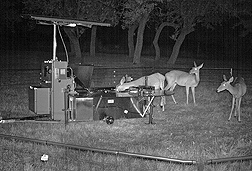This page has been archived and is being provided for reference purposes only. The page is no longer being updated, and therefore, links on the page may be invalid.
| Read the magazine story to find out more. |
|
|
Getting Rid of Cattle Fever Ticks
By Sharon DurhamNovember 2, 2010
Scientists at the U.S. Department of Agriculture (USDA) have developed two strategies to ward off cattle fever ticks that are crossing the border from Mexico into the United States. These ticks transmit bovine babesiosis, commonly known as Texas cattle fever, a deadly disease of cattle that's caused by singled-celled organisms.
Agricultural Research Service (ARS) scientists in Kerrville, Texas, are developing and testing new interventions to eliminate cattle fever ticks within U.S. borders and mitigate the impact on the livestock industry. ARS is USDA's principal intramural scientific research agency, and this research promotes the USDA priority of promoting international food security.
The increased spread of infestation is likely due, at least in part, to the increasing populations of white-tailed deer and other wild hoofed animals along the Texas-Mexico border. To control disease-carrying ticks on deer, ARS entomologist J. Mathews Pound and his colleagues at the agency's Knipling-Bushland U.S. Livestock Insects Research Laboratory developed a device called the 4-Poster Deer Treatment Bait Station.
The bait station lures deer into a feeding apparatus that uses rollers to apply insecticide to the animal's head, ears and neck. As the deer grooms itself, it transfers the insecticide to other parts of its body, killing most of the ticks on the animal.
Pound and colleagues also have reformulated a broad-spectrum antiparasitic medication called doramectin into an injectable, time-release treatment. According to Pound, a single injection of the microspheres greatly reduces the number of treatments needed and protects cattle for up to four months, killing parasites and saving cattle ranchers considerable expense.
The treatment has been tested with excellent results on the island of St. Croix against the tropical bont tick, which transmits a disease called heartwater to cattle. Pound and his colleagues are working to extend the effective period to six months, which would be most useful in treating U.S. cattle for ticks.
Read more about this research in the November/December 2010 issue of Agricultural Research magazine, available online at: /is/AR/archive/nov10/ticks1110.htm .

